As part of the Army 2022 exhibition in Russia, a model is presented that looks like a new elegant submarine concept. The structure, known as the Arcturus Project, is seen in photographs from the exhibition hall paired with an uninhabited large-displacement underwater vehicle called Surrogate-B.
The Army 2022 exhibition, the eighth iteration of this annual event, opened today [August 15, 2022] in the Patriot Park in Kubinka near Moscow. The name Arktur apparently translates into English as Arcturus, which is the brightest star in the constellation of Boet, while Surrogate-V is simply "Surrogate-B".
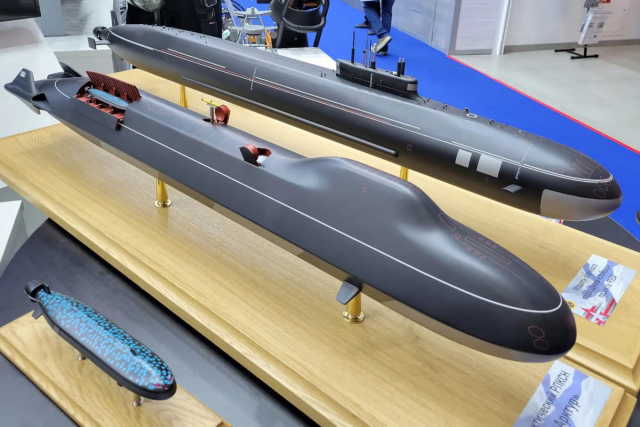
A model of a Russian submarine concept called "Arcturus", in the center, with another one showing in front of it the design of an uninhabited underwater vehicle known as "Surrogate-B". A mock-up of a Borei-A type submarine of the Russian Navy is visible from behind.Details about the Arcturus are extremely limited, but the plate in front of the model seems to indicate that it is intended primarily for a submarine with ballistic missiles, or SSB, optimized for operation in the Arctic region.
The model clearly demonstrates the streamlined shape of the hull with a low-profile cabin.
If the model has the same scale as the model of a submarine with ballistic missiles of Project 955A "Borey", then it is quite possible that they may have very similar overall dimensions and displacement. According to publicly available data, the Borea-A structure is just under 558 feet [170 m] long, about 44 feet [13.4 m] wide at its widest point and displaces about 24,000 tons underwater. However, compared to the Boreas series, the Arcturus project has a more squat and thick body. Other countries, including the United States and Sweden, have studied projects that generally resemble Cold War forms.
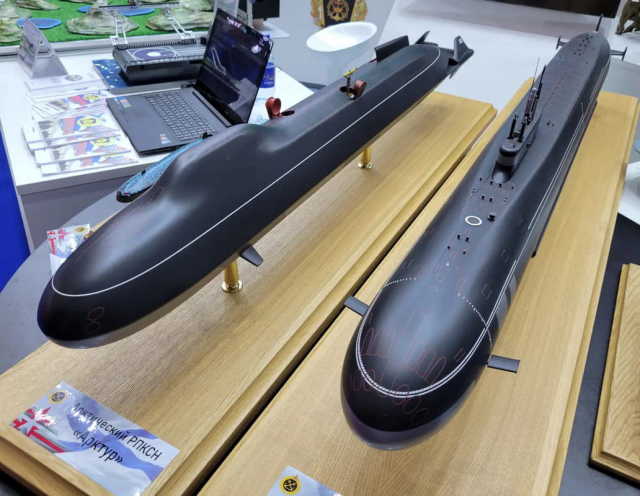
Another view of the model "Arcturus" (left) and Borei-A (right) at the exhibition "Army 2022".It looks like the Arcturus has some kind of fully enclosed propulsion system, which seems designed to allow water to flow through four separate channels on either side of the stern - top and bottom, and then be pushed out through the nozzle sections in the rear.
It is unclear whether the design includes pumping nozzles hidden in the tail of the submarine, although several similar devices using pumping nozzles have been seen on other promising submarine designs. In some cases, pumping engines are more efficient than conventional propellers and can reduce the acoustic signature of a submarine – maintaining maximum silence is the key to the survival of any submarine.
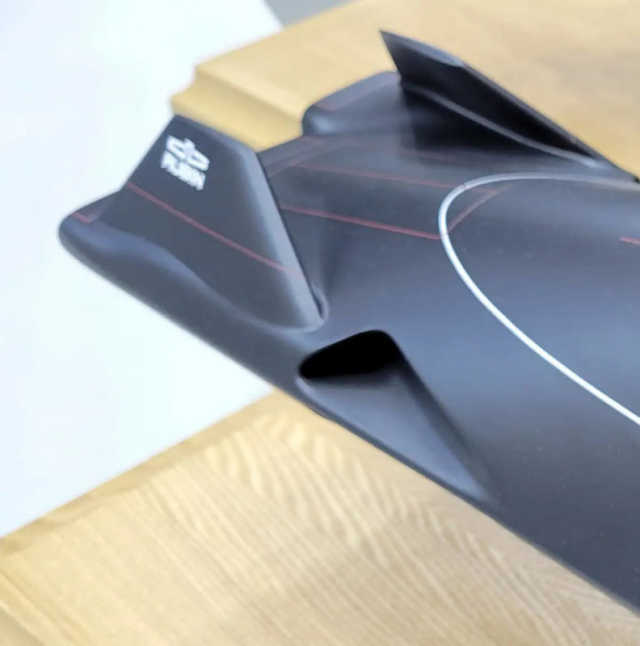
Take a close-up look at what you can see from the configuration of the Arcturus propulsion and its general location in the stern on the model.Anyway, there is no indication that it has any newer propulsion system, for example, an all-electric configuration.
It really evokes thoughts about the fictional caterpillar magnetohydrodynamic engine from Tom Clancy's famous novel The Hunt for Red October and the film of the same name
Instead of the more traditional cruciform or X-shaped rudders, the Arcturus has two sets of inward-sloping vertical tail fins above and below each side of the stern. As for the obvious capabilities of the Arcturus, then, despite the fact that the boat is described as a concept of the SSB, the most attractive elements that immediately catch the eye are two large side compartments for the payload in the aft part, one of which is depicted on the model containing a "Surrogate-B".
One of the aft compartments for the payload "Arcturus", depicted on the model as open, with an uninhabited underwater vehicle "Surrogate-B" inside. The painted panel lines on the model indicate that the design has a second identical compartment on the opposite side of the case.The uninhabited underwater vehicle [UUV] also has a very low profile design, with what looks like a single pump-jet propulsion system in the rear.
On the body of the device there is something like camouflage, consisting of mosaic blue triangles. Such a scheme can make it difficult to visually detect an underwater drone when it is moving on the surface or close to the surface, especially in coastal areas. The UUV may need to operate from time to time, at least near the surface, for other reasons, including receiving new instructions, transmitting data, deploying some payload, and using sensors mounted on the mast.
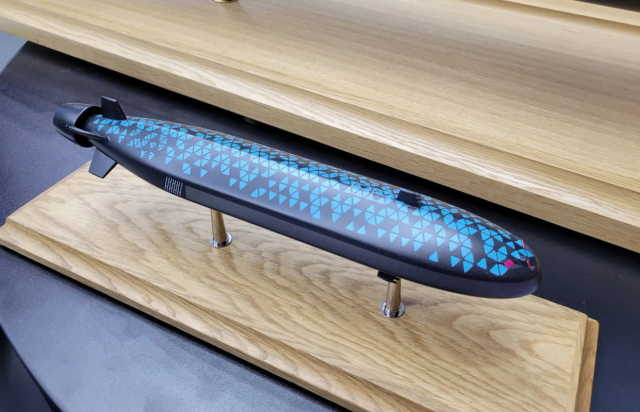
The layout of the underwater uninhabited vehicle "Surrogate-V"As can be seen in the figure below, the autonomous Surrogate-B model demonstrates additional details, including red-painted flat panels on the front, which may reflect sonars or other sensor systems used for navigation.
More interestingly, it has dorsal and ventral fairings in the bow, each with many protruding protrusions that are often associated with stealthy wake detection systems. These systems are designed to detect and track enemy submarines and other objects of interest by changes in the density of water left behind them, and not by their acoustic signature.
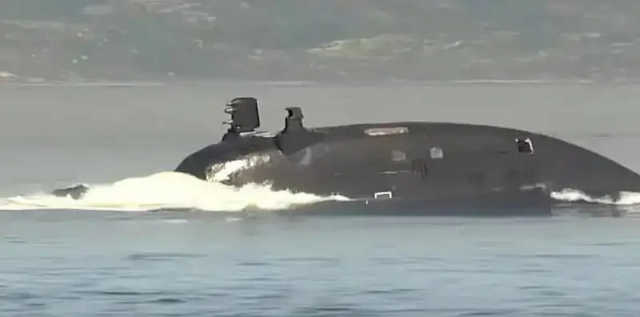
A screenshot from the RT broadcast showing the Russian Navy's Shark II type submarine deckhouse. The fairing on the right side of the deckhouse has been identified as being associated with the Boat Wake Detection System (SOKS), or wake object detection system, and has some similarities with those seen on the Surrogate-B model.The Arcturus project model shows that the design has at least 12 large payload shafts along the rear of the hull.
Two of them are shown open, one with a flat top cover that can reflect a vertically launched missile of some type loaded inside, and the other with an elongated manipulator holding what looks like a small torpedo-like UUV. The latter feature is very similar in general form and function to the systems developed for the four ships of the US Navy "Ohio".
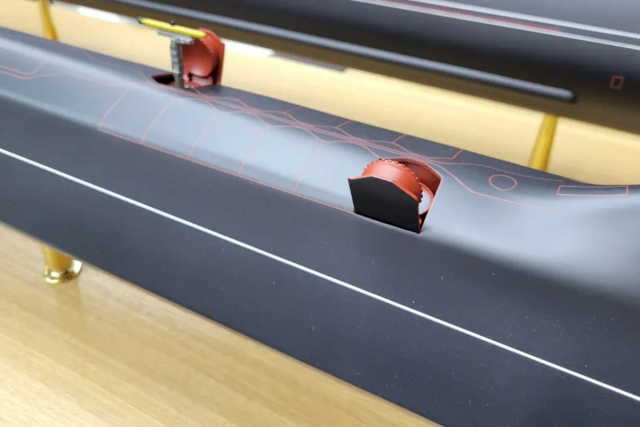
Raised mine covers on the Arcturus hullA slide from the briefing, which depicts a universal system for launching uninhabited underwater vehicles and UAVs through a launch tube on an Ohio-type submarine.
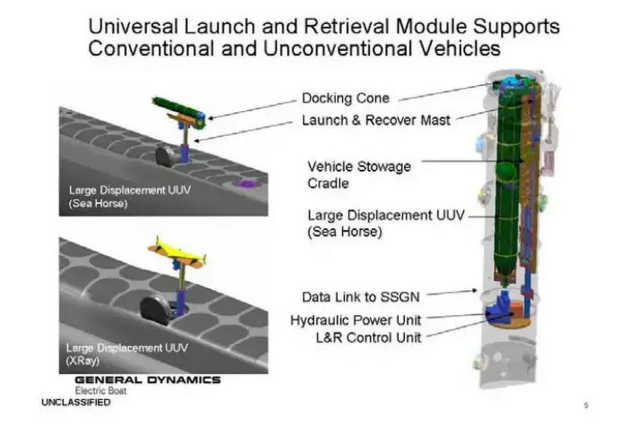
It seems that, in general, a similar system protrudes from one of the open vertical payload shafts on the Arcturus model.The Arcturus project seems to have four torpedo tubes in the bow, two on each side.
In the central part on the nose from above, presumably, the outlines of a large elongated hatch are visible, which is usually found on Russian (and previously Soviet) submarines and is usually associated with loading torpedoes and other payloads launched from a torpedo tube.
The outlines of an array of small hatches on top of the wheelhouse look most likely associated with retractable periscopes and other sensor masts.
The bow of the Arcturus project cabinJudging by what is seen on the model and what is in the official description, "Arcturus" is a very interesting concept for the future SSB, especially with regard to its potential ability to carry up to two UUV "Surrogate–B".
Although it is not entirely clear what the intended capabilities of these uninhabited vehicles are, it is not difficult to imagine how they can be used as underwater "faithful wingmen" to help protect the extremely valuable strategic object from which they are launched and retrieved. With their own sensors, they could act as pickets to monitor enemy submarines, while their mothership "drills a hole in the ocean", hiding to maintain its role as a deterrent to retaliation. Unmanned underwater "surrogates" may also be able to act as decoys at some level and take direct measures against any threats that may arise.
Of course, given that the Arcturus and Surrogate-B projects are at least designed for very quiet work, this pair can potentially perform other tasks. A variant of a carrier ship not equipped with ballistic missiles may be able to approach the target area unnoticed or even be inside it, and then use uninhabited underwater vehicles to perform tasks ranging from intelligence gathering to non-kinetic and kinetic attacks. "Surrogate-B" or other smaller UUVs can help in reconnaissance of targets or other objects of interest, which can then be hit using weapons that could have been loaded on board the Arcturus or other Russian means.
In general, judging by what is seen on the model, "Arcturus" seems to have the potential to become something more than just a PLARB. From what we can see, the concept has some very common elements in common with the US Navy's Ohio SSB and, perhaps to a lesser extent, with the massive Russian special-purpose submarine Belgorod , which is a highly modified Oscar II-type Project 949A SSB and is currently the most the longest of the existing PL. Belgorod can launch Doomsday torpedoes with a nuclear installation and Poseidon nuclear weapons, and also, among other declared capabilities, act as a mothership for manned and unmanned mini-submarines.
It is well known that Russia is very actively engaged in the acquisition of large UUVs, including those that can be launched from launch vehicles. It is also not the first time the Russian government has talked about the development of large submarines focused on the Arctic. Even before global climate change began to open access to the Arctic in new ways, which led to new geopolitical and economic competition and fears of conflict in the region, it has long been known as a platform for submarines and other underwater activities.
For many years, Russia has shown an equally clear interest in expanding its surface and underwater presence in the Arctic, including the potential deployment of underwater nuclear reactors and other new infrastructure on the seabed. Considering all this, it is worth noting that the logo of the Russian design bureau Rubin is applied to the vertical tail of the Arcturus project. Rubin is a prolific designer of submarines and other underwater vehicles, who claimed in the past that since 1901 it accounts for 85% of all developments of Soviet and Russian submarines. His portfolio, of course, includes more traditional projects, for example, "Borey-A".
At the same time, the bureau was responsible for very advanced and highly specialized work, including the conversion of the Belgorod, the Poseidon torpedo, the secretive mini-submarine Losharik, focused on espionage, and the development of many specialized uninhabited underwater vehicles. On the same table as the models "Arcutr" and "Surrogate-B", as well as "Borey-A", another mini-SUBMARINE was exhibited, which, apparently, is a separate new project called "Ye-Amur" [according to the text of the article Ye-Amur. Probably, the author is talking about the Amur e600 project. Then the author's text is saved ].
The "E-Amur" design, which, according to the attached sign, is fully electric, has a more traditional unshielded screw and X-shaped tail rudders, as well as two retractable masts on top. In the bow, it has what looks like four torpedo tubes and what could be eight cells for vertical launch of the payload, as well as the same mosaic "camouflage" pattern on top as the Surrogate-B model. "E-Amur" looks very similar, at least in general concept, to the large-capacity UUV Orca, which Boeing is currently developing for the US Navy.
![Модель проекта «Е-Амур» [«Амур е600»]](https://vpk.name/file/img/model-proekta-e-amur-amur-e600-bzivz5wh-1661835961.t.jpg)
Model of the project "E-Amur" ["Amur e600"]In any discussion of Russia's advanced military development efforts, it is always important to point out that the country has a long history of postponing, postponing and canceling programs due to funding problems.
On top of that, the Russian government, especially its defense sector, is now under a particularly diverse set of tough international sanctions as a result of the war in Ukraine. The Kremlin has to pay for its military machine to work, and now it faces the prospect of making serious investments to replenish its conventional armed forces and restore any occupied territories, depending on how the conflict eventually breaks down.
However, advanced submarine development is one of the areas in which the Kremlin has consistently used significant resources and achieved real results. In recent years, the US military has officially stated that Russian submarines of the current generation are equivalent or almost equivalent to American types in terms of characteristics and capabilities and pose a real threat, even when operating relatively close to the shores of the United States. The ultra-quiet submarine with guided missiles "Yasen-M" attracted the special attention of the authorities of the United States and other NATO member countries.
So, while it is unknown whether the Arcturus, Surrogate-B, E-Amur or anything similar projects will eventually become a reality, they seem to largely reflect the real opportunities that the Russian navy is interested in getting in the future.
According to the materials of the resource thedrive.com/the-war-zoneThe materials of the article contain exclusively the author's estimates and do not reflect the position of the editorial board of IVi

